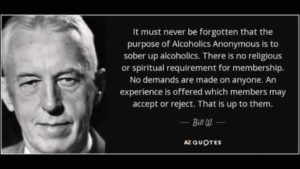
AA Timeline: very cool look at the dates and events that shaped the 12 steps of AA.
ism treatmenyhttp://hindsfoot.org/aatimeline.pdf
Early days of AA and 6 steps.. fascinating! FURIES PICK!
http://hindsfoot.org/steps6.html
| Prior to the writing of the Big Book, A.A. operated with a kind of loosely stated Six Step system. Below is a short version of those Six Steps which Bill W. wrote out in his own hand many years later, in April 1953, probably for Father Ed Dowling. This document was brought to our knowledge by Biker Gary G. (Sparta, New Jersey), who has a copy in his collection. Below is a photograph of a photocopy of the original, which is in the New York A.A. Archives. It reads:
For Ed –
Ever |

|
The Six Steps in A.A. Literature
There are four versions of the Six Steps in the printed literature. Thanks to Arthur S. and Mel B. from the AAHistoryLovers, messages 2286 and 2351, for providing these references. |
| In Alcoholics Anonymous Comes of Age (pp. 160-161), Bill Wilson writes:
“I was in this anything-but-spiritual mood on the night when the Twelve Steps of Alcoholics Anonymous were written. I was sore and tired clear through. I lay in bed at 182 Clinton Street with pencil in hand and with a tablet of scratch paper on my knee. I could not get my mind on the job, much less put my heart in it. But here was one of those things that had to be done. Slowly my mind came into some kind of focus. Since Ebby’s visit to me in the fall of 1934 we had gradually evolved what we called ‘the word-of-mouth program.’ Most of the basic ideas had come from the Oxford Groups, William James, and Dr. Silkworth. Though subject to considerable variation, it all boiled down into a pretty consistent procedure which comprised six steps. These were approximately as follows:
This was the substance of what, by the fall of 1938, we were telling newcomers. Several of the Oxford Groups’ other ideas and attitudes had been definitely rejected, including any which could involve us in theological controversy. In important matters there was still considerable disagreement between the Eastern and the Midwestern viewpoints. Our people out there were still active Oxford Group members, while we in New York had withdrawn a year before. In Akron and vicinity they still talked about the Oxford Groups’ absolutes: absolute honesty, absolute purity, absolute unselfishness, and absolute love. This dose was found to be too rich for New Yorkers, and we had abandoned the expressions.” |
| In the Big Book (on page 292 in the 3rd edition, and page 263 in the 4th edition), Earl Treat (who helped form the first A.A. group in Chicago) gives the Akron version of the six steps as they were taught in 1937.
“The day before I was due to go back to Chicago, a Wednesday and Dr. Bob’s afternoon off, he had me down to the office and we spent three or four hours formally going through the Six-Step program as it was at that time. The six steps were:
Dr. Bob led me through all of these steps. At the moral inventory, he brought up some of my bad personality traits or character defects, such as selfishness, conceit, jealousy, carelessness, intolerance, ill-temper, sarcasm and resentments. We went over these at great length and then he finally asked me if I wanted these defects of character removed. When I said yes, we both knelt at his desk and prayed, each of us asking to have these defects taken away …. Dr. Bob then led me through the restitution step, in which I made a list of all of the persons I had harmed, and worked out ways and means of slowly making restitution.” |
| In a July 1953 Grapevine article titled “A Fragment of History: Origin of the Twelve Steps” (reproduced in The Language of the Heart, page 200) Bill W wrote:
“During the next three years after Dr Bob’s recovery our growing groups at Akron, New York and Cleveland evolved the so-called word-of-mouth program of our pioneering time. As we commenced to form a society separate from the Oxford Group, we began to state our principles something like this:
Though these principles were advocated according to the whim or liking of each of us, and though in Akron and Cleveland they still stuck by the Oxford Group absolutes of honesty, purity, unselfishness and love, this was the gist of our message to incoming alcoholics up to 1939, when our present Twelve Steps were put to paper.” |
| Another version of the six steps appears in the pamphlet “Three Talks to Medical Societies by Bill W., Co-Founder of Alcoholics Anonymous,” page 8 (this was a presentation given by Bill in April 1958 to the New York City Medical Society on Alcoholism). In describing the visit made by Ebby T to his home, Bill wrote:
“Next Ebby enumerated the principles he had learned from the Oxford Group. In substance here they are as my friend applied them to himself in 1934:
|